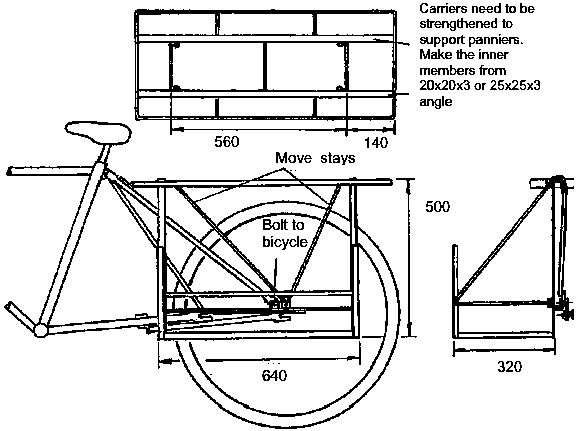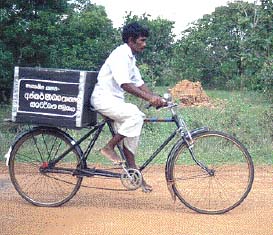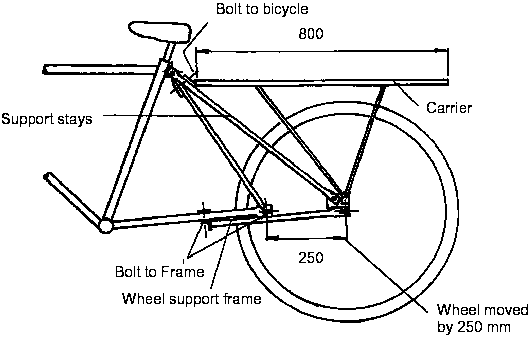How to Use a Bicycle to Carry Things
Contents
Bicycles
Introduction
Isolation is one of the key elements of poverty, isolated communities have little or no access to goods and services, and few opportunities to travel beyond their immediate surroundings. This restricts agricultural productivity, reduces health and educational and limits opportunities for employment and political opportunity.
Limited financial resources prevents investment in means of transport maintaining the position of poverty and isolation. Consequently, there is a need to develop alternative, more affordable means of transport
Developing such systems requires consideration of four key elements:
• the improvement of village level infrastructure such as paths, tracks, and footbridges
• the provision of adequate and affordable rural transport services
• the siting of services closer to the communities , thereby removing or reducing the need for lengthy travel
• the promotion and use of intermediate means of transport including; pack animals, sledges, animal carts, cycle based transport and some low cost motorised devices. One of the more common types of intermediate transport is the bicycle.
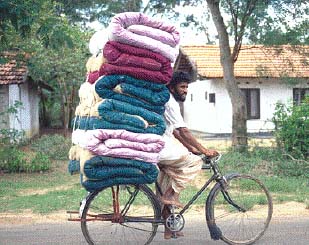
Figure 1: Cyclist carrying mattresses, Puttalam District. An example of ordinary bicycle used to transport difficult loads ©Practical Action
Bicycles
Bicycles are a low cost means of transport that can improve access to water, health facilities and, for example, address stove marketing problems faced by woman producer groups in Kenya
The bicycle is still expensive for poorer families in Africa and can cost between 20 to over 100 per cent of a rural household’s annual income. Therefore, transport needs to be supported by an affordable system of manufacture, supply, and repair.
Affordability is related to the availability of spare parts and repair services, which are sometime lacking in rural areas. Several projects have attempted to boost local economics by encouraging artisanal production of suitable transport and improve the local capabilities of metal workers to maintain and repair bicycles and other types of transport.
Panniers
The carrying capacity of the bicycle can be greatly increased by attaching panniers either side of the wheel. However, the loads in the panniers must be reasonably well balanced. Panniers are particularly suited to carrying containers such as used for carrying water.
Panniers may simply be sacks or woven baskets hung from lengths of wood or bamboo fixed across the carrier or may be frames manufactured from wood or steel. They need to be as light as possible.
The design shown is a steel frame, which may be either welded or pinned together so that it can be folded up when it is not in use.
The base and sides may be filled in with wire mesh (weldmesh), wooden slats or canvas type material. The ends can be filled in on fixed panniers but not on fold-up designs.
Bicycle extensions
These low cost adaptations of standard bicycles enable larger and more bulky loads to be carried on an extended rear carrier.
The load that can be carried is limited by the strength of the rear wheel and tyre. A strengthened wheel can be used so that the limiting factor is the load capacity of the tyre.
|
Extended cycle user (ITDG design). W Aloysius Fernando, cultivator of mainly plantains & peanuts, sells peanuts in nearby towns. With the extended cycle, he can now transport enough to meet demand (1200 packets as oppose to 400 packets on original bicycle). With increased business earnings he began to cultivate a larger area of land and could hire a peanut shelling machine. |
This particular bicycle adaptation requires; the chain to be lengthened, the brackets for the rear break to be moved, and the brake rods to be lengthened. The frame does not have to be cut or modified in any way.
Construction of extension with small (20”) rear wheel
The advantages of a small rear wheel are; there is more space for the load, the load is lower and easier to balance, the wheel is stronger, and the bicycle is easier to pedal. The main disadvantage is that the smaller wheel does not ride as easily over pumps and potholes.
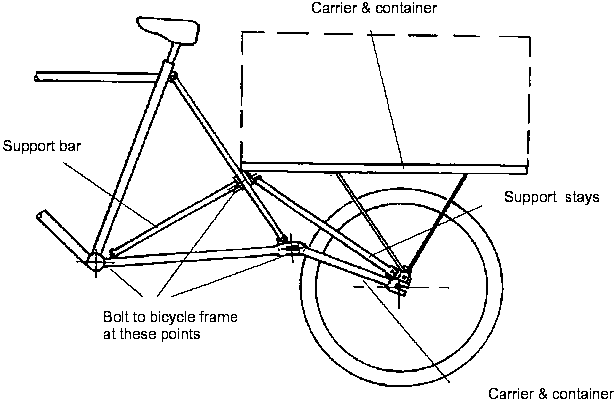
Figure 5: Construction of extension with small (20”) rear wheel
Bicycle taxis
The Bicycle taxi or Boda boda has become popular in Uganda and kenya, they operate for hire fromstands in towns, bus stops and market centres. The name boda bodas is said to come from hthe time when the East African Community existed and there was free movement across the boarder between Uganda and Kenya. Travellers were offered transport to the boarder by bicycle-riders shouting ‘Border Border’ to attract passengers.
Converting a bicycle to a taxi requires reinforced forks, stronger brakes, a passenger seat and footrests, and cushions. New seat designs enable woman to ride side-addle should help to improve access.
Although the work is hard, the operators can earn a living despite a lack of formal education. The community transport organisation in Ndhiwa and The Kibos Cycle Taxi Association of Kisumu, Western Kenya has worked in conjunction with ITDG’s Rural Transport programme in Western Kenya to:
• Enhance the safety of bicycle taxis.
• Provide a cycle lane along the Kibos road
• Set up a mini-medical insurance scheme for passengers and operators
• Provide a credit scheme and repair fund for the members
References and further reading
• Low-cost Load-carrying Devices: The Design & Manufacture of Some Basic Means of Transport Ron Dennis and Alan Smith ITDG Publishing 1995
• Puncture Prevention Techniques for Low Cost Vehicles Michael Ayre & Alan Smith
• Forum News. The International Forum for Rural Transport and Development A quarterly newsletter looking at the issues of transport with animal power, bridges, bicycles, gender and transport, financing, engineering, sustainable rural livelihoods, community planning. IFRTD’s address is shown below.
Useful contacts and addresses
I. T. Transport Ltd.
The Old Power Station
Ardington, Nr Wantage
Oxon
OX12 8QJ
United Kingdom
Tel: +44 1235 833753 /821366
Fax: +44 1235 833753/821366
Website: http://www.ittransport.co.uk/
Consultants in transport for rural development
International Forum for Rural Transport and Development
IFRTD
2 Spitfire Studios
67-73 Collier Street
London N1 9BE
United Kingdom
Tel: +44 (0)20 7713 6699
Fax: +44 (0)20 7713 8290
Website: http://www.gn.apc.org/ifrtd
The International Forum for Rural Transport and Development is a global network of individuals and representatives from government, academia, multilateral and bilateral donor agencies, consultancies and technical institutions, national and international NGOs and groups of community organisations in 83 countries in Africa, Asia, Europe and North and
South America. There are over 1800 members in the network. The Forum’s long-term vision is of a world in which rural communities, particularly those who are poor and disadvantaged, have improved accessibility and mobility.
Forum News is produced by the Secretariat, four times a year in English, French and Spanish. Members receive the newsletter free of charge. Each issue of the newsletter is based on a specific theme. Themes addressed in past newsletters have included sustainable rural livelihoods, gender and transport, engineering for transport, networking, maintenance, and community participation.
Useful website addresses
International Bicycle Fund
Website: http://www.ibike.org/index.htm
A non-governmental, non-profit, advocacy organisation, promoting sustainable transport and international understanding. Major areas of activity are non-motorised urban planning, economic development, bike safety education, responsible travel and cycle tourism, and cross-cultural, educational programmes.
Pan Africa Bicycle Information Network (PABIN)
Website: http://www.ibike.org/pabin/index.htm
Working to improve opportunities for bicycle transport and low-cost mobility to improve productivity, the quality of life and the environment in Africa.
Re-cycle
Website: http://www.re-cycle.org
Re-cycle is a charity whose mission is to collect and ship second hand bicycles and parts to Less Developed Countries. Re-cycle help to teach local people the skills of how to repair and maintain bicycles, to improve their lives in a sustainable manner.
Afribike
Website: http://www.afribike.org/
Afribike is an independent, not-for-gain, company with registered offices in Southern Africa and The Netherlands. Activities include; training workshops, low-cost bicycle procurement programs, bicycle enterprise projects and IMT (intermediate means of transport) advocacy work.
Xaccess
Website: http://www.xaccess.org/index.html
XAccess (Xtracycle Access Foundation) is the non-profit sister company of Xtracycle LLC. They makes extended load-bearing bicycles for developing countries and have projects in Kenya and South Africa.
Work Bike
Website: http://www.workbike.org/
Promoting the use of cycle transport for work activities
WorldBike
Website: http://www.worldbike.org/big_boda
Usefull addresses
Practical Action
The Schumacher Centre for Technology & Development, Bourton on Dunsmore, RUGBY, CV23 9QZ, United Kingdom.
Tel.: +44 (0) 1926 634400, Fax: +44 (0) 1926 634401
e-mail:practicalaction@practicalaction.org.uk
web:www.practicalaction.org

